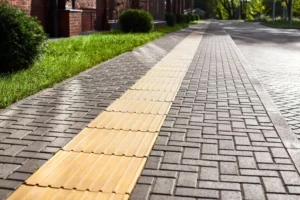Welcome to our blog at Cronus Concrete. We’re thrilled to provide you with engaging and informative content around concrete design, concrete demolition, and concrete construction. Today, we’ll be answering the question: “How wide are sidewalks?” It’s a common inquiry that we hear often and we’re more than happy to shed some light on the subject.
Understanding the width of sidewalks is crucial, not just for our line of work, but also for city planners, architects, and homeowners. It plays a significant role in urban planning and accessibility. A well-designed sidewalk can greatly enhance the aesthetic appeal of a property and the overall pedestrian experience. So, without further ado, let’s get into it.
Why the Width of Sidewalks Matters in Concrete Design
Have you ever considered the width of sidewalks while strolling through your neighborhood or during your morning commute? It may seem like a minor detail, but it plays a significant role in the overall design and functionality of a concrete sidewalk. At Cronus Concrete, we make it our mission to help you understand why this matters.
The width of a sidewalk  determines the level of comfort and safety for pedestrians. It also influences how the sidewalk integrates with the rest of the built environment. This is particularly true in urban areas, where sidewalks often need to accommodate a variety of functions.
determines the level of comfort and safety for pedestrians. It also influences how the sidewalk integrates with the rest of the built environment. This is particularly true in urban areas, where sidewalks often need to accommodate a variety of functions.
Comfort and Safety
A wide sidewalk provides more space for pedestrians to move and makes the journey more comfortable. It reduces the risk of collisions, especially in high-traffic areas. A width of at least 5 feet is recommended, as it allows two people to walk side by side or pass each other without difficulty.
Integration with the Environment
A wider sidewalk can also help to integrate the sidewalk with other elements of the urban environment. For instance, it can provide space for street furniture, greenery, or outdoor café seating, enhancing the aesthetic appeal of the area and potentially boosting local business.
Compliance with Regulations 
There are also legal considerations. The width of sidewalks is often determined by local laws and regulations, designed to ensure accessibility for all, including those with mobility impairments. Not only do we at Cronus Concrete strive to meet these standards, but we also aim to exceed them whenever possible, to create safe, comfortable, and attractive sidewalks for everyone.
In conclusion, the width of a sidewalk plays a crucial role in concrete design. It affects comfort, safety, integration with the environment, and legal compliance. As specialists in concrete design, demolition, and construction, we at Cronus Concrete understand the importance of getting these details right. So whether you’re planning a new project or considering improvements to existing infrastructure, we’re here to help.
How Regulatory Requirements Affect Sidewalk Width
Have you ever wondered why sidewalks are as wide as they are? The truth is, it’s not arbitrary. Sidewalks widths are determined by a set of regulatory requirements that take into account various factors, including public safety, accessibility, and urban planning. Let’s delve into how these regulations shape the sidewalks we use every day.
The Role of ADA Requirements
The Americans with Disabilities Act (ADA) plays a significant role in determining sidewalk widths. The ADA mandates that sidewalks must be at least 36 inches (3 feet) wide. This width allows for the comfortable passage of wheelchairs and is considered a minimum for accessibility.
Sidewalks in Residential Areas 
In residential areas, sidewalks may not need to be as wide. Generally, they range from 4 to 5 feet wide to allow two people to walk side by side or pass each other comfortably. This width also permits small maintenance equipment to pass.
Sidewalks in Commercial Zones
In contrast, sidewalks in commercial zones are often wider, ranging from 5 to 10 feet, and in some cases, even wider. This is to accommodate higher foot traffic, street furniture, outdoor café seating, and window shoppers. The wider sidewalks contribute to the vibrant street life characteristic of commercial areas.
Local Building Codes and Ordinances
Local building codes and ordinances can also influence sidewalk widths. Different municipalities may have their own requirements based on their unique needs and planning considerations. It’s advisable check to with local regulations for specific requirements in your area.
In conclusion, various regulatory requirements greatly influence the width of sidewalks. These regulations ensure that sidewalks are accessible, safe, and functional for everyone. Remember, the next time you take a leisurely walk or jog on your local sidewalk, there’s a lot of careful planning that goes into that simple stretch of pathway.
Factors to Consider When Deciding the Width of Sidewalks
When planning a sidewalk construction project, one of the most critical factors you need to consider is its width. The width of a sidewalk will determine how comfortable it is for people to use and navigate, as well as the amount of space available for features like benches, planters, and other amenities. Here are the key factors to consider:
- Anticipated Pedestrian Traffic:
 The volume and type of pedestrian traffic will greatly influence the required width of the sidewalk. For instance, areas with high pedestrian traffic, like shopping districts and schools, may require wider sidewalks to accommodate the large number of users.
The volume and type of pedestrian traffic will greatly influence the required width of the sidewalk. For instance, areas with high pedestrian traffic, like shopping districts and schools, may require wider sidewalks to accommodate the large number of users. - Accessibility Requirements: Federal laws dictate that sidewalks must be accessible to people of all abilities. Therefore, you need to ensure that your sidewalk is wide enough to accommodate wheelchairs, which typically require a minimum width of 36 inches.
- Street Furniture and Amenities: If you plan to include elements like benches, planters, bike racks, and other amenities, you will need to factor these into your sidewalk width calculations, ensuring there’s enough room for pedestrians to comfortably navigate around them.
- Buffer Zones: Sidewalks often include a buffer zone to separate pedestrians from vehicular traffic. The size and presence of this zone can affect the total width of the sidewalk.
Remember, the goal is to create a space that is safe, accessible, and comfortable for all users. Careful planning and consideration of these factors will help you achieve this.
Find the Right Balance
While it’s important to provide ample space for pedestrian traffic and amenities, it’s also crucial not to go overboard. A sidewalk that is excessively wide can lead to unnecessary costs, wasted space, and other issues. The key is to find a balance that meets the needs of the community and aligns with federal regulations and best practices.
Let Cronus Concrete Help
Planning a sidewalk construction project can be complex, but you don’t have to navigate it alone. At Cronus Concrete, we provide comprehensive concrete design, demolition, and construction services to help you bring your vision to life. Contact us today to learn more about how we can assist you with your project.
Impact of Pedestrian Traffic on Sidewalk Width
Ever wondered how pedestrian traffic impacts the width of sidewalks? Well, you’re in the right place to find out. Here at Cronus Concrete, we’re experts in not only concrete design, construction and demolition, but also in understanding the nuances of sidewalk planning, including the crucial aspect of width determination.
The width of sidewalks can vary, but it is generally between 5 and 12 feet. The amount of pedestrian traffic directly influences this range. Let’s delve a little deeper into this topic.
High Pedestrian Traffic Areas
In areas that experience high pedestrian traffic, such as city centers or around busy institutions, wider sidewalks are necessary. This is to accommodate the increased number of pedestrians and ensure their safe and efficient movement. In these areas, the width of the sidewalk can extend up to 12 feet or more.
Residential Areas
In contrast, in residential areas or places with less pedestrian traffic, the sidewalks can be narrower. A width of 5 to 6 feet is common for these sidewalks, providing ample space for residents to walk comfortably.
Understanding the Balance
It’s all about striking the right balance. Sidewalks need to be wide enough to handle the volume of pedestrian traffic but not so wide that they unnecessarily consume space that could be used for other purposes, such as green spaces or bike lanes. This balance is a key consideration in urban planning and design.
So, next time you’re out and about, take a moment to consider the width of the sidewalks you’re walking on – it’s more than just a slab of concrete; it’s a carefully considered element of urban planning and design.
How Sidewalk Width Affects Property Values
Ever wondered if the width of your sidewalk could have an impact on your property value? It might seem improbable, but the size of that concrete walkway could indeed play a role in the worth of your property. Let’s delve into why this is the case.
First and foremost, sidewalks serve as a crucial element of the pedestrian infrastructure. They are designed to provide safe and convenient passage for people traveling on foot. In this light, the width of your sidewalk becomes a significant factor.
Accessibility and Comfort 
A wider sidewalk means better accessibility. It can comfortably accommodate more people, including those using wheelchairs or pushing strollers. Naturally, such a user-friendly feature tends to increase the appeal of your property.
Social Interaction
Believe it or not, sidewalks can also foster social interaction. A wider sidewalk allows pedestrians to walk side by side, facilitating conversation. A home in a neighborhood that encourages social interaction is likely to have a higher property value.
Increased Safety
Wider sidewalks can create a buffer between the street and the buildings. They provide a greater sense of safety from moving vehicles, which is another attractive feature for potential property buyers.
Urban Appeal 
Finally, having a wider sidewalk can lend an urban, city-like charm to your property. It gives off a vibe of being in the heart of the action, and that’s a characteristic that many people are willing to pay more for.
In conclusion, while it may not be the first thing that comes to mind, sidewalk width can indeed affect the value of your property. From improving accessibility to enhancing safety, a wider sidewalk can be a significant boon.
At Cronus Concrete, we provide concrete design, concrete demolition, and concrete construction services. If you’re thinking about widening your sidewalk or any other concrete project, feel free to reach out to our friendly and professional team. We would be more than happy to assist you in enhancing the value of your property.
How Regulatory Requirements Affect Sidewalk Width
When considering how wide sidewalks are, it’s crucial to understand the significant role that regulatory requirements play. These guidelines, set by local and national governments, ensure that sidewalks are safe, accessible, and functional for all users.
Building Codes and ADA Regulations
Firstly, there are building codes and regulations, such as the Americans with Disabilities Act (ADA), which require sidewalks to be a certain width to accommodate individuals with disabilities. The ADA mandates that sidewalks must be at least 36 inches (or 3 feet) wide. This width is considered the minimum for wheelchair accessibility. However, it’s important to note that more width might be necessary in areas with heavy foot traffic or outdoor seating.
Local Government Regulations
Local government regulations are another key factor. Different cities and states may have their own specific rules regarding sidewalk width. For instance, some cities require wider sidewalks various factors, including building codes, local regulations, and urban planning guidelines, can influence the actual dimensions. These regulations ensure that sidewalks cater to the needs of all users, promoting safety and accessibility. As providers of concrete design, demolition, and construction, Cronus Concrete is committed to adhering to these standards, ensuring that our projects are up to code and meet the needs of the communities we serve.
Common Materials Used For Constructing Sidewalks
Concrete is the most common material used for constructing sidewalks. It is durable, long-lasting, and can withstand heavy foot traffic. The width of a concrete sidewalk can vary depending on the expected foot traffic and the available space. Typically, a sidewalk should be at least 4 feet wide to accommodate one person walking comfortably.
Asphalt is another material used for constructing sidewalks. It is less expensive than concrete but not as durable. The width of an asphalt sidewalk should be similar to that of a concrete sidewalk, at least 4 feet wide.
Pavers are a popular choice for sidewalks because they come in a variety of colors and designs. The width of a paver sidewalk can vary depending on the size and shape of the pavers used. Generally, a paver sidewalk should be at least 3 feet wide.
Gravel is a less common material used for constructing sidewalks. It is inexpensive but not as durable as concrete or asphalt. The width of a gravel sidewalk should be at least 3 feet wide to accommodate one person walking comfortably.
is a less common material used for constructing sidewalks. It is inexpensive but not as durable as concrete or asphalt. The width of a gravel sidewalk should be at least 3 feet wide to accommodate one person walking comfortably.
Overall, the width of a sidewalk depends on the expected foot traffic, available space, and the material used for construction. It is important to consider these factors when designing and constructing a sidewalk to ensure it is safe and accessible for pedestrians.For more informative blogs or articles visit our website.
Frequently Asked Questions
1. Why does the width of sidewalks matter in concrete design?
The width of sidewalks is crucial because it affects the comfort and safety of pedestrians, integration with the environment, compliance with regulations, and overall urban planning. It can enhance the aesthetic appeal of properties and the pedestrian experience.
2. How does sidewalk width influence pedestrian comfort and safety?
Wider sidewalks provide more space for pedestrians to move comfortably and reduce the risk of collisions, especially in busy areas. A recommended width of at least 5 feet allows two people to walk side by side or pass each other easily.
3. What is the significance of integrating sidewalks with the environment?
A wider sidewalk allows for the inclusion of street furniture, greenery, and outdoor seating, enhancing the visual appeal of the area and potentially benefiting local businesses.
4. How does regulatory compliance impact sidewalk width?
Local laws and regulations, such as the Americans with Disabilities Act (ADA), determine minimum sidewalk widths to ensure accessibility for everyone, including those with mobility impairments.
5. What role do ADA requirements play in sidewalk width determination?
The ADA mandates that sidewalks must be at least 36 inches (3 feet) wide to accommodate wheelchair accessibility.
